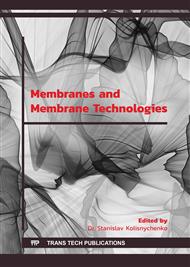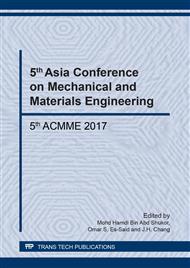p.127
p.133
p.145
p.151
p.157
p.163
p.171
p.177
p.182
Preparation of Porous Polymer Membrane with Controllable Pore Size via Spray Spinning
Abstract:
Polymer membranes with fixed pore size or narrow pore size distribution can be used for special separation. However, polymer membranes prepared by conventional method usually have wide pore size distribution and the pore size is hard to control. Here we prepared a porous polymer membrane with uniform pore size via spraying a blend of polystyrene (PS) and polyethylene oxide (PEO) on a filtration paper. Dissolving the water-soluble component (PEO) forms the pore and varying the ratios of PEO in the blend controls the pore size. The pore size and size distribution are also affected by processing parameters, such as the flow rate of solution and carrier gas, and gap length. The morphologies of the membrane are observed using scanning electron microscopy (SEM). The novel polymer membrane with controllable and uniform pore size will be used for the separation of solutes with predictable sizes.
Info:
Periodical:
Pages:
157-162
Citation:
Online since:
November 2017
Authors:
Keywords:
Price:
Сopyright:
© 2017 Trans Tech Publications Ltd. All Rights Reserved
Share:
Citation:



